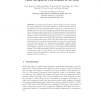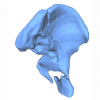ECCV
2010
Springer
15 years 6 months ago
2010
Springer
We present an interactive, hybrid human-computer method for object classification. The method applies to classes of objects that are recognizable by people with appropriate expert...
ECCV
2010
Springer
15 years 6 months ago
2010
Springer
This paper presents a linear solution for reconstructing the 3D trajectory of a moving point from its correspondence in a collection of 2D perspective images, given the 3D spatial ...
100
click to vote
ECCV
2010
Springer
15 years 6 months ago
2010
Springer
In this work we propose a hierarchical approach for labeling semantic objects and regions in scenes. Our approach is reminiscent of early vision literature in that we use a decompo...
142
Voted
ECCV
2010
Springer
15 years 6 months ago
2010
Springer
Approximate Nearest Neighbor (ANN) methods such as Locality Sensitive Hashing, Semantic Hashing, and Spectral Hashing, provide computationally ecient procedures for
nding objects...
135
click to vote
ECCV
2010
Springer
15 years 6 months ago
2010
Springer
This paper is addressing the problem of realigning broken
objects without correspondences. We consider linear transformations between
the object fragments and present the method ...
219
Voted
ECCV
2010
Springer
15 years 6 months ago
2010
Springer
Graph matching is an essential problem in computer vision and machine learning. In this paper, we introduce a random walk view on the problem and propose a robust graph matching al...
109
click to vote
ECCV
2010
Springer
15 years 6 months ago
2010
Springer
Motion blurs confound many computer vision problems. The fluttered shutter (FS) camera [1] tackles the motion deblurring problem by emulating invertible broadband blur kernels. How...
128
Voted
ECCV
2010
Springer
15 years 6 months ago
2010
Springer
We present an analysis of the spatial covariance structure of an articulated motion prior in which joint angles have a known covariance structure. From this, a well-known, but ofte...
108
click to vote
ECCV
2010
Springer
15 years 6 months ago
2010
Springer
We present spatio-temporal feature descriptors that can be inferred from video and used as building blocks in action recognition systems. They capture the evolution of ``elementar...
ECCV
2010
Springer
15 years 6 months ago
2010
Springer
Abstract. Naive Bayes Nearest Neighbor (NBNN) is a feature-based image classifier that achieves impressive degree of accuracy [1] by exploiting ‘Image-toClass’ distances and b...


